
OC 949-428-4500
LA 310-460-2444
Embryonic Stem Cells form your entire body while Adult Stem Cells have a more specialized function.
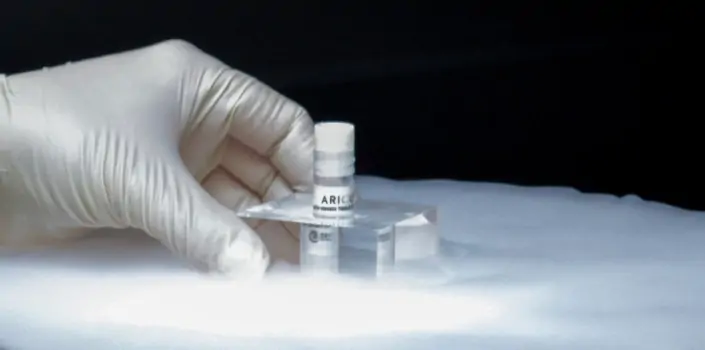
A vial of stem cells being removed from cryogenic storage.
New bio-medical scientific studies have recently discovered that stem cells can be used medically to recreate live healthy tissue to replace damaged or diseased tissue.
In other words, instead of repairing a damaged liver, shoulder joint, or heart, imagine if you could simply create a new liver, shoulder joint or heart!
Stem cells can be collected from several sources in the human body, and once they have been properly prepared, Regenerative Medicine specialists around the world report they can provide useful – even miraculous – treatments for all organ systems of the human body. In this comprehensive post, we will discuss more about this complex, compelling, exciting and life-changing topic.

When a stem cell divides, it splits into 1. a copy of itself (self-renewal) and 2. a specialized cell (differentiation).
Stem cells refer to “original” cells that are “undifferentiated” which means they have not yet become cells that are a part of a specific organ system. In fact, stem cells have the potential to become “differentiated” and become specialized cells that are transformed into different organs tissue.
Like the cells of any organ such as your kidney, skin, or liver, differentiated cells have a specialized purpose that perform a specific function.
Before stem cells differentiate into specialized cells, they can divide through the process of mitosis which leads to the production of more stem cells. This is called the self-renewal capacity which ensures that every organ in your body always has enough stem cells in it that can create, repair and replace tissue that is damaged, diseased and no longer functioning properly.
Humans have two types of stem cells: embryonic stem cells and adult stem cells
Human embryonic stem cells (hESCs) are the initial group of cells that comprise the embryo during the first few days after conception. Each of these embryonic stem cells has the potential to differentiate into every type of human cell and all the organ systems of a developing baby.
hESCs can be expanded in the lab forever (the creation of more cells). As a result, they hold enormous promise for developmental research, drug screening, cell-based therapy, and disease modeling. A thorough understanding of the signaling processes driving hESC differentiation into early cell lineages is critical. Significant progress has been made in understanding the growth factors, intracellular pathways, and transcriptional regulatory networks that regulate hESCs self-renewal and differentiation processes
Human embryonic stem cells exist only in human embryos that are no more than 1 week old. In other words, embryonic cells can be found only during the very first week of the development of a human’s embryo. This first week of development is called the blastocyst stage.
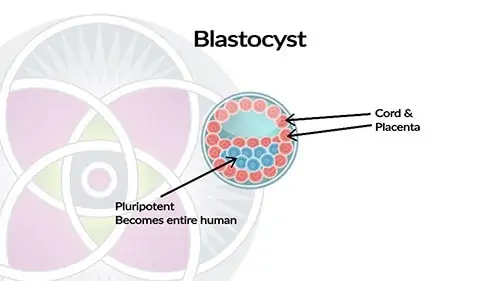
During the first week of embryo development, called the blastocyst stage, is where embryonic stem cells are procured. This stage also contains what will become the placental stem cells or Mesenchymal Stem Cells (MSCs).
In the medical world, these embryos usually come from In-Vitro fertilization clinics, where human eggs are fertilized with human sperm under laboratory conditions and then frozen for future implantation into the mother when she is ready to carry a baby.
After the first week of development, the blastocyst develops two layers of cells: the outer layer of cells forms the placenta, amniotic fluid and the umbilical cord, while the inner layer will eventually differentiate into different cell “lineages” in order to create all the necessary structures and organs of a complete human baby that will grow into an adult (see above image). All this leads to the production of specialized cells that form the different organ systems.
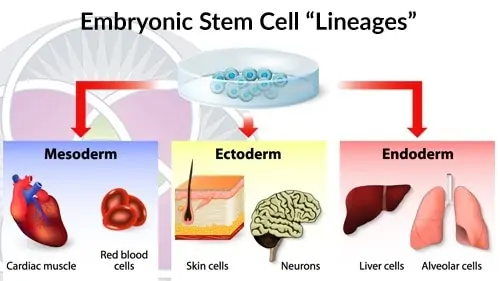
Embryonic stem cells develop into 3 different “lineages”.
As original embryonic stem cells develop, three different “lines” of cell types emerge. The three germ layers – mesoderm, endoderm, and ectoderm – create the cellular blueprint for all the tissues and organs that will form during embryonic development. Normal embryonic development requires the precise creation of all three layers as well as the complex signaling between each of them.
During embryonic development, the endoderm is the innermost germ layer that develops the linings of the respiratory and gastrointestinal passages, as well as their related organs such as the liver and pancreas.
Mesodermal cells are the most prevalent in the human body, representing a wide range of cell types such as the musculoskeletal system (bone, cartilage, and muscle), cardiovascular system (heart, blood, and blood vessels), and connective tissues.
Organs derived from embryonic ectoderm include mammary glands, CNS, external ear, melanocytes, cornea, brain, nerves, teeth, eyes, and the epithelium of the skin.
Every cell in a human body comes from one of these three fundamental cell lineages.

Each organ system has adult stem cells that are specifically programed and equipped to care for that organ.
The second category, Adult Stem Cells, are the stems cells that can be found in each of the developed organ systems. These organ specific stems cells, are in charge of repairing and regenerating new cells and tissue of their specific organ
For example, stem cells found in the liver take care of liver cells, and can generate new liver tissue whenever needed. Accordingly, kidney stem cells do the same for kidneys, and skin stem cells do that for skin. Thus, each organ system has stem cells that are specifically programed and equipped to care for, repair and regenerate tissue of that organ.
Adult stem cells that are found in different organs are also known as “somatic” stem cells. They can remain in a non-dividing state for years. However, when the organ tissue becomes injured or diseased the stem cells become activated and start dividing. These somatic/organ stem cells have the capacity to divide indefinitely in a process called “self-renewal”.
Current scientific understanding reveals that adult stem cells, as a group, can only supply derivative cells indefinitely if they are replenished through cell division. Self-renewal is defined as a balanced combination of stem cell division and differentiation that results in a relatively constant number of stem cells. Importantly, both the essential replenishment function of adult stem cells and the associated “self-renewal” traits of differentiation, division, and lifetime persistence apply to the stem cell community within that organ as a whole. They are not always applicable to each individual stem cell.
Whether or not stem cells from a specific organ can also become other types of organ cells and tissues is still a controversial and debatable subject.

Adult stem cells can be harvested from the patient’s femur bone
These stem cells can be harvested by extraction, which involves drilling into the patient’s bone, usually the iliac crest bone (part of the pelvis bone just above the hip), or a leg bone (Femur, in the thigh – or Tibia, below the knee). As you can imagine, this is not a very pleasant procedure.
Bone marrow transplantation can cure numerous blood illnesses as well as other diseases, such as solid tumors.










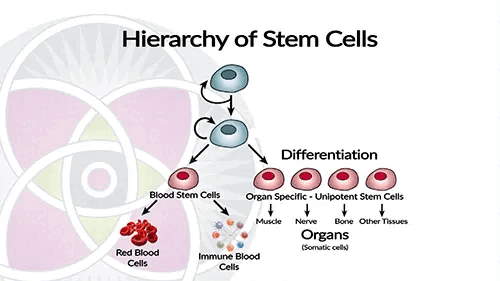
Stem cells can have one of the following potencies, totipotent, pluripotent and multipotent.
Cell potency is stem cells’ ability to differentiate into specialized cell types as part of the tissue of a specific organ.
Stem cells can have one of the below-presented potencies:
Cells that have the potential to create all cell types including placental cells. Only the earliest of cells of an embryo during the first 4-5 days after fertilization are totipotent.
These stem cells can transform into all the cell types that will differentiate into specialized tissues that develop into the various organs of a complete human.
These cells will only make certain cell types, being quite limited in their capacity. Generally speaking, the stem cells that exist in an organ, such as a liver, pancreas or skin, are designed to only produce new liver, pancreas or skin cells/tissue.
There are two major problems associated with the use of embryonic, or fetal, stem cells.
These cells will only make certain cell types, being quite limited in their capacity. Generally speaking, the stem cells that exist in an organ, such as a liver, pancreas or skin, are designed to only produce new liver, pancreas or skin cells/tissue.
As these cells can be obtained only from a developing human fetus, they necessarily involve interfering with the potential development of a human being. This is an ethical mine field and should be.

Fetal stem cell are dangerous because they can develop into any kind of adult tissue.
As these cells still retain their pluripotent potency, they can develop into any kind of adult tissue. Therefore, there is a significant risk that if these cells are inserted into an adult, that the wrong kind of tissue might develop.
The most serious problem about the clinical use of embryonic stem cells is their tumorigenicity. This may not be surprising considering their innate capacity for fast proliferation and the fact that teratoma formation is the gold standard for measuring pluripotency, but multiple studies mention that they also collect mutations and chromosomal abnormalities in culture.
In certain ways, embryonic stem cells resemble cancer cells rather than regenerative/reparative cells. Their proclivity for proliferation and tumorigenicity is a concerning, if not insurmountable, barrier to their clinical utilization.
Say for example, these cells are injected into a damaged or diseased human liver in hopes that they will generate new liver tissue, but instead, bone tissue is created. Obviously, this unintended consequence could be very detrimental.
Therefore, as a general rule, fetal stem cells are considered dangerous and are NOT used in clinical medicine.
Adult stem cells found in fully formed human organs, whose purpose is the repair and regeneration of that specific organ. Though all adult stem cells share certain characteristics, modern science is discovering that they also differ from each other in distinct and important ways.
The most commonly utilized adult stem cells are extracted from either bone-marrow, fat, or blood. These stem cells have fully developed and unique cellular identity of the person from which they were harvested, and therefore will cause an immunological rejection if introduced into any other human.
Therefore, adult stem cells can only be utilized by the person from whom they were harvested.
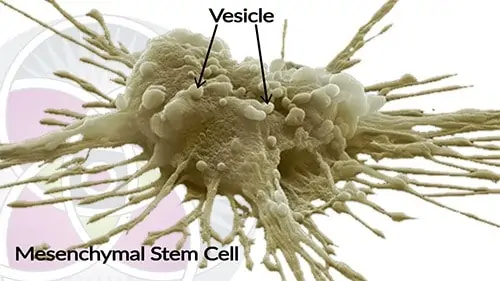
Image of a Wharton’s jelly mesenchymal stem cell harvested from the placental tissue.
Placental tissue includes the placenta, amniotic fluid and the umbilical cord. This tissue is unique in that it is not part of the developing embryo nor does it belong to the mother.
Also know as Wharton’s Jelly stem cells, they are not programed to become specialized organs like all other stem cells. These stem cells have essentially already reached their final developmental destiny, and upon the birth of the baby, all the placental tissue is discarded.
And yet, the placenta, the amniotic fluid, and the umbilical cord have stem cells that can be harvested at the same time the baby is born.
As these stem cells do NOT genetically belong to the mother, baby, or father, they do not have a genetically distinct identity that would make them incompatible with other humans. Therefore, they CAN be used medically for other adult humans without causing immunological rejection.
These placental stem cells have additional biochemical and cellular characteristics that make them different from other stem cells, and most promising for the advancement of Regenerative Medicine.
The advancement of Stem Cell research is an increasingly important area of the medical field. Regenerative Medicine specialists around the world report they can replace or heal damaged cells or tissues in the body. You can even say they work as a built-in repair system for the entire human organism.
Adult stem cells have been used in human treatments and stem cell therapies for many years.
Adult stem cells are called the body’s “natural” solution by Regenerative Medicine specialists around the world. This is because they can be found in our bodies in their natural form. When any part of human physiology is in need of healing due to a disease or damage, these cells provide a repair mechanism to replenish your tissues.
Despite research on the potency of a wide range of stem cells for wound healing, adipose-derived stem cells (ASCs) appear to have the fewest limitations for clinical applications. Studies suggest that ASCs can improve wound healing by promoting angiogenesis and/or vascularization, modulating immune response, and inducing epithelialization in the wound.
Wharton’s jelly-Mesenchymal stem cells (WJ-MSCs) currently show the most promise for stem cell therapies. They proliferate rapidly, have a wide spectrum of multipotency, and are hypo-immunogenic.
In comparison to bone marrow MSCs (BM-MSCs) and adipose-derived MSCs (ADMSCs), Wharton’s jelly-Mesenchymal stem cells (WJ-MSCs) grow much more quickly and have a similar immunological profile and multipotency differentiation.
In addition, umbilical cords are regarded as medical waste, their clinical usage in stem cell therapy raises no ethical concerns.
WJ-MSCs have showed significant and promising therapeutic potential. Several approaches have been developed to increase the therapeutic potency of WJ-MSCs in cellular therapy. Treatment of WJ-MSCs with pharmacological substances, cytokines, growth factors, hormones, and vitamins has shown promising results in increasing WJ-MSCs potency.
One thing is for sure, the future of stem cell medicine and its discoveries is going to be exciting.
Everything on our website comes from from reputable publications, books and scientific journals, most of which are available on PubMed and other government websites. These include Meta-Analysis’, Randomized Controlled Trials, Clinical Trials, Systematic Reviews, Books and Documents. We encourage you to read the science, in order to separate fact from fiction, so that you can arrive at a full understanding of what is best for your body. We would be honored to be a part of that educational journey with you.
AMA Regenerative Medicine & Skincare | 1570 Brookhollow Dr., Santa Ana, CA 92705 | 6310 San Vicente Blvd STE 285, Los Angeles, CA, 90048 Disclaimer: though everything on our website comes directly from reputable publications and scientific journals; and though thousands of these articles are available on official government websites (https://pubmed.ncbi.nlm.nih.gov), they have not been evaluated by the Food and Drug Administration and the FDA has not certified, endorsed or approved any of the scientific findings as methods of treating or diagnosing any diseases or illnesses.